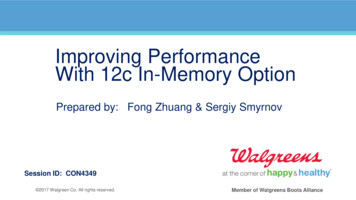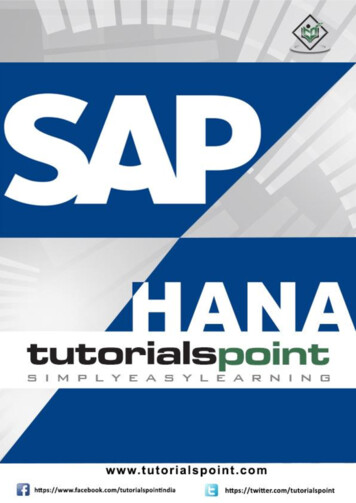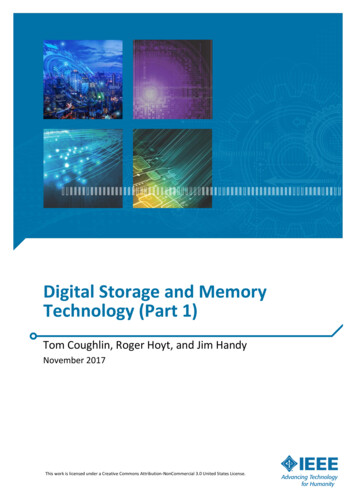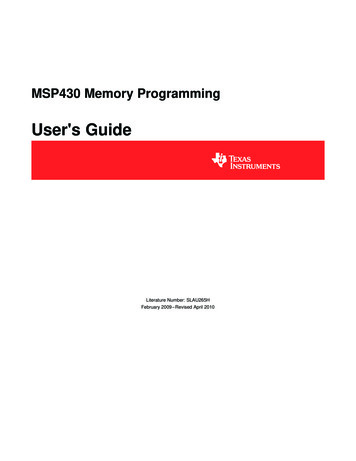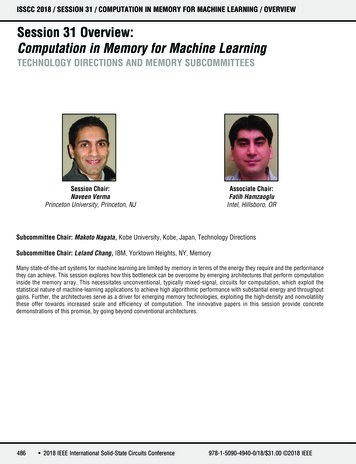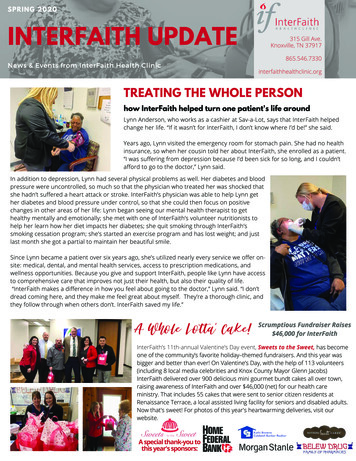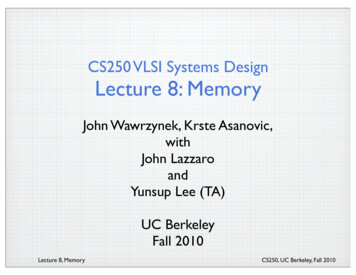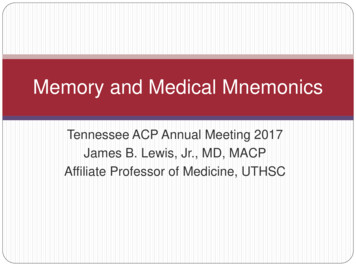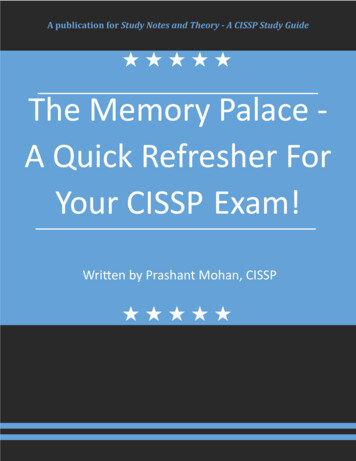
Transcription
The Memory Palace - A Quick Refresher For Your CISSP Exam!Page 1A publication for Study Notes and Theory - A CISSP Study GuideThe Memory Palace A Quick Refresher ForYour CISSP Exam!Written by Prashant Mohan, CISSPA publication for Study Notes and Theory - A CISSP Study Guide
The Memory Palace - A Quick Refresher For Your CISSP Exam!TABLE OF CONTENTSExam BreakdownCISSP Exam MindsetNote from the author/DisclaimerDomain 1: Security and Risk Management3456Domain 2: Asset Security18Domain 4: Network Security57Domain 3: Security EngineeringDomain 5: Identity and Access ManagementDomain 6: Security Assessment and TestingDomain 7: Security Operations20768589Domain 8: Software Development Security110Copyright Credits (Continued)123Copyright Credits 122A publication for Study Notes and Theory - A CISSP Study Guide
TheMemoryMemoryPalacePalace- A- SSPExam!Exam!ThePagePage33Exam BreakdownDomainPercentage of examDomain 1: Security and Risk Management15%Domain 2: Asset Security10%Domain 3: Security Architecture and Engineering13%Domain 4: Communication and Network Security14%Domain 5: Identity and Access Management (IAM)13%Domain 6: Security Assessment and Testing12%Domain 7: Security Operations13%Domain 8: Software Development Security10%Total100%A publication for Study Notes and Theory - A CISSP Study Guide
The Memory Palace - A Quick Refresher For Your CISSP Exam!CISSP Exam MindsetPage 4 Your role is a risk advisor, CISO, or Senior Management. Do NOT fix problems. Fix the process, not the problem. Who is responsible for security? How much security is enough? All decisions start with risk management. Risk Managementstarts with identifying/valuating your assets. Human life is always #1 priority. Security should be “baked in”, rather than “bolted on”. Layered defense! People are your weakest link. Always think about the overall risk and remediation steps foreach technology, tools, components or solution. Think security? Think about CIA. Behave ethically. All controls must be cost justified (safeguards) Senior management must drive the security program (businessproposal, positive ROI).A publication for Study Notes and Theory - A CISSP Study Guide
The Memory Palace - A Quick Refresher For Your CISSP Exam!Note From The AuthorPage 5I would like to thank Radha Arora for drafting and reviewing thedocument with me to make it a better version. I would also like to thank LukeAhmed for allowing me to release the document on his CISSP platform and forassisting me in compiling it to produce a distributable format.The Memory Palace"It's a memory technique. A sort of mental map. You plot a map with a location. It doesn't haveto be a real place. And then you deposit memories there. That, theoretically, you can neverforget anything. All you have to do is find your way back to it." - Sherlock, BBC TV SeriesDisclaimer This document is completely free for anyone preparing for their CISSP exam. Itis not meant for sale or as part of a course. It is purely a contribution to alignwith the Fourth Canon of the ISC2 Code of Ethicsto "Advance and Protect the Profession". This book has been written with an objective to have all the CISSP conceptshandy at one place. It is an original creation of the author. However, a fewterms, concepts, tips, images, language(s) are a result of inspiration and derived from multiple sources (books, videos,notes). The intent is not to violateany copyright law(s). If the reader comes across any text, paragraph(s), image(s)which are violating any copyright, please contact the author atprashantmohan.cissp[at]gmail[dot]com so that this can be removed from thebook. The content is completely on the guidelines of ISC2 and I’ve tried my best effortto make them as simple as possible for others to understand. This document isnot affiliated or endorsed by ISC2. The document is by no means a primary resource for the CISSP exam. Readersare expected to go through their primary materials first and then use thisdocument as a quick reference.A publication for Study Notes and Theory - A CISSP Study Guide
The Memory Palace - A Quick Refresher For Your CISSP Exam!Page 6Domain 1: Security and Risk ManagementConfidentiality - Sharing of the information with the intended people. Data should beprotected in all the states (At rest, in Process, in motion)*Exam Tip: To maintain confidentiality, you should always encrypt data. {In Motion - TLS} {Atrest - AES - 256}Examples of confidentiality requirements PII/PHI must be protected against disclosure using approved algorithms. Password and sensitive field should be masked. Password at rest must not be stored in clear text. TLS must be used for transmitting sensitive information. The use of unsecure transmission (e.g. FTP etc.) should not be allowed. Log files should not store sensitive information.Integrity - Protection against system or software modification: System should perform asexpected. Code injection can modify the database Input validation is a mitigation technique Data Integrity: Ensuring the accuracy and reliability of data CRCs, checksums, Message Digests, Hashes, MACs Internal and External consistency Some examples of Integrity Requirements: Input Validation should be used in all forms to ensure the data control language is not entered, and field size and data types are enforced.Published software should provide the user with a message digest so the user canvalidate the accuracy and completeness of the software.Subjects should be prevented from modifying data, unless explicitly allowed.Availability - Data should be available all the time whenever it’s required. Metrics Used: MTD/RTO/RPOA publication for Study Notes and Theory - A CISSP Study Guide
The Memory Palace - A Quick Refresher For Your CISSP Exam!Page 7Domain 1: Security and Risk Management SLAs MTBF/MTTR Examples of Availability requirements: Software shall meet availability requirements of 99.999%, as specified inthe SLA Software should support access up to 200 users simultaneously Software must support replication and provide load balancing Mission critical function of the software should be restored to normaloperations within 30 minutesIdentification : User should be uniquely IdentifiedAuthentication : Validation of an entity’s identity claimAuthorization : Confirms that an authenticated entity has the privileges and permissionsnecessary.Auditing : Any activity in the application/system should be audited (Identify technical issues/Breaches)Accountability: Tracing an action to a subjectA publication for Study Notes and Theory - A CISSP Study Guide
The Memory Palace - A Quick Refresher For Your CISSP Exam!Page 8Domain 1: Security and Risk ManagementPlansStrategic - Longer (5 years)Tactical - Mid/Short (6 months to 1 year)Operational - Shortest (Days to weeks)Primary goal of change management is to prevent security compromises.Protection Mechanism:1.Layering - Defense in depth (Series & Parallel)2.Abstraction - Used for classifying data or assigning roles3.Data Hiding4.EncryptionData ClassificationGovernmentPrivateTop veUnclassifiedPublicTop Secret--- Grave DamageSecret--- Critical DamageConfidential--- Serious DamageUnclassified--- No damageA publication for Study Notes and Theory - A CISSP Study Guide
The Memory Palace - A Quick Refresher For Your CISSP Exam!Page 9Domain 1: Security and Risk ManagementSecurity Roles & Responsibilities1.Senior Manager - Management (Ultimately responsible)2.Security Professional - Information Security team3.Data Owner - Classifies the data4.Data Custodian - Takes care of day to day activity (performing back ups)5.User - End user6.Auditor - Responsible for reviewing the dataControl FrameworksCOBIT/COSO - Framework and Goals (What do we need to do?)ITIL - How do we achieve those goalsDue Care - Doing the right thing / Prudent ManDue Diligence - Practicing activities to maintain due careSecurity Policy - Mandatory Document that define scope of security needed by theorganizationStandards - Mandatory requirementsBaseline - Minimum security requirementGuidelines - Optional. How Standards and Baselines should be implementedProcedure - Step by step document. Maintain integrity of the businessThreat ModellingIt’s a security process where potential threats are identified, categorized and analyzed.Proactive Measure : Design and developmentReactive Measure : Once the product has been deployedGoal: (a) To reduce the number of security related design and coding defects(b) To reduce the severity of any remaining defectsOverall result is reduced riskA publication for Study Notes and Theory - A CISSP Study Guide
The Memory Palace - A Quick Refresher For Your CISSP Exam!Page 10Domain 1: Security and Risk ManagementIdentifying Threats:1.Focused on Assets - Identify threats on valuable assets2.Focused on attackers - Identify potential attackers and their goals3.Focused on Software - Potential threat against developed softwareSTRIDE Model - Developed by Microsoft (purpose is to consider range of compromiseconcerns)S - SpoofingT - TamperingR - RepudiationI - Information DisclosureD - Denial of ServiceE - Escalation of privilegeDREAD Model - Designed to provide a flexible rating solution that is based on the answers of 5main questions:D - Damage potential (How severe the damage likely to be if the threat is realized)R - Reproducibility (How complicated it is for the attacker to reproduce the exploit)E - Exploitability (How hard it is to perform the attack)A - Affected users (How many users are likely to be affected)D - Discoverability (How hard it is for an attacker to discover the weakness)RISK TerminologyAsset Valuation - Value of an assetRisk: Likelihood that a threat will exploit a vulnerability in an asset.Threat: Has the potential to harm an asset.Vulnerability: A weakness; a lack of safeguardExploit: Instance of compromiseControls: Protective mechanisms to secure vulnerabilities Safeguards: ProactiveA publication for Study Notes and Theory - A CISSP Study Guide
The Memory Palace - A Quick Refresher For Your CISSP Exam!Page 11Domain 1: Security and Risk Management Countermeasure: Reactive mechanismTotal Risk: Amount of risk before the safeguard is implemented.Secondary Risk: Risk event that comes as a result of another risk response.Residual Risk: The amount of risk left over after a risk response.Fallback Plan: “Plan B”Workaround: Unplanned response (for unidentified risk or when other response does notwork).Risk Management Risk Assessment: Identify Assets, Threats, Vulnerabilities Quantitative - Qualitative - Experience (Delphi technique) Risk Analysis: Value of potential Risks (ALE,SLE) Risk Mitigation: Responding to Risk Risk Monitoring: Risk is FOREVERSLE AV*EFARO Annual rate of occurrenceALE SLE * AROCost Benefit Analysis : ALE Before safeguard - ALE after implementing safeguard - annual costof safeguard Value of the safeguard to companyRisk Treatment : MARTM - MitigateA - AcceptR - RejectT - Transfer*Exam tip: Primary goal of risk management is to reduce the risk to an acceptable levelA publication for Study Notes and Theory - A CISSP Study Guide
The Memory Palace - A Quick Refresher For Your CISSP Exam!Page 12Domain 1: Security and Risk ManagementControlsTechnical, Administrative, PhysicalDeterrent - DogsPreventive - SoD (Protects against collusion)Detective - Job rotation (detects fraud)Compensating - Alternate controlCorrective - Back upRecovery - Restore back upsDirective - Security policyDocumentation Review: Process of reading the exchanged material and verifying them againstthe standards and expectationRisk Management FrameworkC - Categorize InformationS - Select security controlI - Implement security controlA - Assess the security controlA - Authorize Information systemM - Monitor security controlBusiness Continuity Management (BCM)Business Continuity Planning Business Organization Analysis BCP Team Validate BOAA publication for Study Notes and Theory - A CISSP Study Guide
The Memory Palace - A Quick Refresher For Your CISSP Exam!Page 13Domain 1: Security and Risk Management BIA Continuity Planning Approval and implementation MaintenanceDisaster Recovery1.2.3. Critical Systems MTD, RTO, RPO Offsite selection Recovery of critical systems Normal systems Get back to primary siteProcess & Planninga.Business Organization Analysisb.BCP Team selectionc.Validates BOAd.Resource requiremente.Legal and regulatory requirementBusiness Impact Analysisa.Identify Assets and valueb.Risk Identification (Threats)c.Likelihood estimation (ARO)d.Impact Assessment (Exposure Factor)e.Resource Prioritization (Analysis)Continuity Planninga.Strategy planning - bridges gap between BIA and Continuity planningb.Provision and process - people, buildings & infrastructure (Meat of BCP)c.Plan Approval - (Senior Management support and approval : Very Important)d.Plan implementatione.Training and EducationA publication for Study Notes and Theory - A CISSP Study Guide
The Memory Palace - A Quick Refresher For Your CISSP Exam!Page 14Domain 1: Security and Risk Management4.BCP Documentationa.Continuity plan goalsb.Statement of importancec.Statement of prioritiesd.Statement of organization responsibilitye.Statement of urgency and timingf.Risk assessmentg.Risk acceptance/mitigation*Exam tip: Human safety is your first priority. Data is secondLawsCategories of Law1.Criminal law: Law enforcement is involved (Murder)2.Civil Law: Designed to provide an orderly society & govern matters which are not criminal. {United states code} (Law suite, defamation cases)3.Administrative Law: Covers topics as procedures to be used within federal agency.4.Comprehensive Crime Control Act (1984) - 1st Law against computer crime5.a.Unauthorized access of classified informationb.Cause malicious damage to federal system excess 1000c.Modify medical resourcesComputer Fraud and Abuse Act (1986): Amendment in CCCA. Creation of malicious codewas introduced (1994)6.Computer Security Act (1987): Amendment in CFAAa.NIST given responsibility to develop guidelinesb.Mandatory periodic trainingc.Classified information to be dealt by NSAd.Unclassified information to be dealt by NISTA publication for Study Notes and Theory - A CISSP Study Guide
The Memory Palace - A Quick Refresher For Your CISSP Exam!Page 15Domain 1: Security and Risk Management7.Paper work Reduction Act (1995): Office of Management Budget (OMB) - Approval before requesting information from public8.Government Information Security Reform Act (2000): Places burden of maintaining thesecurity & Integrity of Government information.9.Federal Information Security Management Act (2002): NIST develops FISMA implementation. It requires federal agencies implement an information security programthat covers the agency’s operations.Intellectual Properties1.Copyright: Original creation of author. Covers the expression of idea. It’s covered till 70years after the death.a.Digital Millennium Copyright Act (DMCA)i.Prohibition of attempts to break copyright.ii.Protection to ISP if internet is used as crime.2.Trademarks: logos, way of packing. Granted for 10 years and then renewed for 10 years.3.Patents: Protects the rights of inventor. 20 years from the date patent is applied.4.Trade secret: If disclosed, business may be impacted. KFC, Coca cola recipe. No protection (By Law). Only way to protect is proper security control.5.Licensing: Contractual - written by software vendors.Shrink wrap - written outside software packaging.Click through - During installation agreement of terms and conditions.Cloud - License agreement is displayed on the screenUniform Computer Information Transaction Act - Law against the breach of licensing.Safe Harbor - Doing business outside EU.Wassenar Agreement - Import/Export of encrypted goods.A publication for Study Notes and Theory - A CISSP Study Guide
The Memory Palace - A Quick Refresher For Your CISSP Exam!Page 16Domain 1: Security and Risk ManagementPrivacyUS Privacy Law: 4th Amendment --- Searching private property without search warrantAgencies should only retain records which are used and destroy others.a.Electronic Communication Privacy Act (1986): Invading electronic privacy is a crime.b.Communication Assistance for Law Enforcement (1994): Wiretapping with proper ordersis allowed.c.Economic and Protection of Proprietary Information Act (1996): Theft of economic information would be called as espionage.d.Health Insurance Portability and Accountability Act (1996): Protection of PHIe.Health Information Technology for economic and Clinical Health (2009): Business Associates (BA) and covered Entity should have agreement through Business AssociateAgreement (BAA). It protects BA (Who handles PHI on behalf of HIPAA).f.Children’s online privacy protection act (2000): Protects information collection forchildren (under 13 years)g.Graham-Leach-Bailey’s Act (1999): Law for financial institutes, Banksh.US Patriot Act (2001): Blanket approval for surveillance. Terrorist activity. Came after9/11i.Family Educational Rights and Privacy Act: Educational institutes receiving funding fromgovernment.j.Identity Theft Act (1998)European Union Privacy LawLaw giving directive outlining privacy measures that must be in place for protecting personaldata processed by information system.Criteria to be met:1.Consent2.Contract3.Legal Obligation4.Vital interest of the data subject5.Balance between the interests of the data holder and the interests of the dataA publication for Study Notes and Theory - A CISSP Study Guide
The Memory Palace - A Quick Refresher For Your CISSP Exam!Page 17Domain 1: Security and Risk ManagementKey rights of individual about whom the data is held:1.Right to access the data2.Right to know the data’s source3.Right to correct the inaccurate data4.Right to withhold consent to process in some situations5.Right of legal action should these rights be violated.European Union Global Data Protection Regulation - GDPRLaw applies to all organizations that collect data from EU residents or process that informationon behalf of someone who collects it.a.Breaches should be informed within 24 hoursb.Centralized data protection authoritiesc.Individuals will have access to their own datad.Data portability to facilitate the transfer of personal information between servicee.providers.Right to be forgotten - delete information if it’s no longer required.Contracting & Procurement: Any services or applications being on-boarded by an organization,should be reviewed properly before signing off the contract. Should ask appropriate questionsbefore on-boarding the vendor:a.What controls are in place to protect organization’s informationb.What type of sensitive information are stored, processed, or transmitted by thec.vendor?What type of security audits does the vendor perform, and what access does theclient have to those audits?A publication for Study Notes and Theory - A CISSP Study Guide
The Memory Palace - A Quick Refresher For Your CISSP Exam!Domain 2: Asset SecurityPage 18Managing Sensitive Data1.Marking - Labelling (protection mechanisms are assigned on the basis of data labels)2.Handling sensitive data - secure transportation of data through entire lifecycle3.Storing sensitive data - proper encryption (AES256)4.Destroying Sensitive Data when no longer required.Data Remanence: Left over data after deletion process is completed. (as magnetic flux)Degaussing: Way to remove data remanence. Generates heavy magnetic field. (Only effectiveon magnetic media)Note: it does not affect CD, DVD or SSDSolid state drive (SSD): Uses integrated circuitry instead of magnetic flux.Note: SSD does not have data remanence so no degaussing is required. Best method of sanitizing SSD is destruction.Methods of removing data.a.Erasing: Simple deletion of file. Data can be overwritten and removedb.Clearing (overwriting): Unclassified data is overwritten. Overwritten data can be retrieved in labs using some tools.c.Purging: Intense form of clearing. Prepares a media to be reused in less sensitive environment. Data non-recoverable using known methods. High classified data is not purged(e.g. Top Secret)d.Declassification: Process of using a media in an unclassified environment.e.Sanitization: Combination of processes to remove data ensuring data cannot be recovered at any cost. (Destruction of media without physically destroying it)f.Destruction: Final stage in the lifecycle of media. Most secure method of sanitization.Methods includes, incineration, crushing, shredding, disintegration and dissolving usingchemicals.A publication for Study Notes and Theory - A CISSP Study Guide
The Memory Palace - A Quick Refresher For Your CISSP Exam!Domain 2: Asset SecurityPage 19Retaining Assets: Should be retained as per the business requirement and local laws and regulations. e.g. emails above 90 days should be deleted.Identifying Data Roles:1.Data Owners: Ultimately responsible for the data.2.System Owners: Person who owns the system which processes the sensitive data.3.Business Owners: Sales dept. head will be responsible for sales dept. However, systemsbeing used in sales dept. will be owned by IT dept.4.Data Custodian: Take efforts to protect the data, backup. (does task directed by owner)5.Data processors: Person who processes personal data on behalf of data controller6.Data Controller: Person who controls processing of data.*Company collecting employee information for Payroll - Data Controller*Company passing it to 3rd party for processing - Data ProcessorCalifornia Online Privacy Protection Act (COPPA): Any website collecting PII, needs to protectthe privacy.Rules of behavior: Rules identified for the protection of data. It applies to the users not thesystem.A publication for Study Notes and Theory - A CISSP Study Guide
The Memory Palace - A Quick Refresher For Your CISSP Exam!Domain 3: Security EngineeringPage 20CryptographyEncryption: Plain text Algorithm key Cipher textCaesar Cipher: Earlier Cipher a.k.a ROT3 (Substitution Cipher)A -- DB -- EC -- FROT 12A -- MB -- NVulnerable to Frequency AnalysisEnigma Codes : German (Watch “The Imitation Game” movie)Purple Machine: JapanGoals of Cryptography: P - Privacy (Confidentiality)A - AuthenticationI - IntegrityN - Non-RepudiationKey is also called crypto variablesKey Space: Range of values that are valid for use as a Key.Key space 2n where n us the bit sizee.g. AES 256 has the key space of 2256Kerckhoff Principle: Algorithm should be made public for examination and to test them.Symmetric Key (aka Private Key/Secret Key)Asymmetric Key (aka Public Key/Shared Key)A publication for Study Notes and Theory - A CISSP Study Guide
The Memory Palace - A Quick Refresher For Your CISSP Exam!Domain 3: Security EngineeringPage 21Cryptography -- Art of converting plain text to cipher textCryptanalysis -- Art of breaking the cipherCryptology -- Science of Cryptography and CryptanalysisCryptosystem -- Implementation of code/cipher in Hardware or SoftwareCryptography Mathematics:1. AND - X Y (Both True then True)XYX Y0000101001112. OR - X V Y (Any one value True then True)XYXVY0000111011113. NOT - X Y (Reverse the Input)X X01104. Exclusive OR - X Y (Only True if only ONE value is TRUE)XYX Y000011101110A publication for Study Notes and Theory - A CISSP Study Guide
The Memory Palace - A Quick Refresher For Your CISSP Exam!Domain 3: Security EngineeringPage 22Modulo Function: Remainder after the division8 mod 6 26 mod 8 610 mod 2 0One way function: The output cannot be reversedNonce: Random number to provide randomness to cryptographic function. Nonce must beunique number each time. {Initialization Vector (IV)}Zero Knowledge proof: Sharing of proof without sharing actual knowledge.Split Knowledge: Separation of Duties and Dual ControlM of N controlM: Minimum number of people for taskN: Total number of people for taskWork Function: Time and effort require to break a cryptography (it also tells the strength ofcryptography)Code: Secret Codes {Words, Phrases}Cipher: Converts plain text to cipher textTransposition Cipher: Rearranging the letters of plain textSubstitution Cipher: Replace each character or bit with different character. e.g. Vigenere Cipher (Polyalphabetic Cipher)A publication for Study Notes and Theory - A CISSP Study Guide
The Memory Palace - A Quick Refresher For Your CISSP Exam!Domain 3: Security EngineeringPage 23One Time Pads: Type of substitution cipher (aka Vernam Ciphers)*Exam tip: When used properly, they are unbreakable One Time Pads must be randomly generated One Time Pads must be physically protected Each One Time Pad must be used only once Key length should be equal to length of the messageRunning Key Ciphers: AKA Book Ciphers where Encryption key is equal to the length of themessage. (Key is chosen from a common book or newspaper)Block Cipher: Encrypts in huge block (Slow but secure)Stream Cipher: Encrypts bit wise (Fast but not that secure)Confusion: Complication in Substitution cipherDiffusion: One change in plain text, change the cipher text in multiple ways.Modern CryptographyCryptographic Keys: Keys are kept secret. Algorithms are made public to test them (KerckhoffPrinciple)*Exam tip: Key length directly relates to work function of cryptosystemSymmetric Key: (Secret Key/Private Key) P A I NSame key is used to encrypt and decrypt the message. Key distribution is a challenge (Out of band) n(n-1)/2 total number of keys required. Non scalable but great speedA publication for Study Notes and Theory - A CISSP Study Guide
The Memory Palace - A Quick Refresher For Your CISSP Exam!Domain 3: Security EngineeringPage 24Asymmetric Key: (Public Key) P A I NOne key is used to encrypt and another key is used to decrypt Every user has a key pair (Public Private) 2n total number of keys required Scalable but very slowReal World example: SSL/TLS uses Hybrid Cryptography. Encrypt message with symmetric keyand encrypt the key using asymmetric key.Symmetric KeyAsymmetric KeySingle shared keyHave key pairsOut of band exchangeIn band exchangeNot scalableScalableFastSlowBulk EncryptionSmall blocks, digital signature,Certificated, envelopsP A I NPAINHashing: Message Digest (Provides Integrity)One way mathFile changes -- Hash changesRequirement for Hasha. The input can be of any lengthb. The output has a fixed length.c. The hash function is relatively easy to compute for any input.d. The hash function is one-way (meaning that it is extremely hard to determine theinput when provided with the output).e. The hash function is collision free (meaning that it is extremely hard to find two messages that produce the same hash value).A publication for Study Notes and Theory - A CISSP Study Guide
The Memory Palace - A Quick Refresher For Your CISSP Exam!Domain 3: Security EngineeringPage 25Hash Algorithms:1. MD2 - Message Digest 22. MD5 (128 bit)3. SHA - 0 (Secure Hashing Algorithm)4. SHA - 1 (160 bit)5. SHA - 2Hasher Message Authentication Code (HMAC) - algorithm implements a partial digital signature—it guarantees the integrity of a message during transmission, but it does not provide fornonrepudiation.Symmetric Key Algorithms: P A I N1. DES2. 3DES3. AES4. RC-45. RC-56. 2 Fish7. Blow fish8. IDEA9. CAST10. MARS1. DES (Data Encryption Standard):Block Size: 64 bitsKey Size: 56 bitsRounds: 16a. Electronic Code Book (ECB): Least secure as it uses Secret key (static) Used forshortest transmission (data units are encrypted). No IVb. Cipher Block Chaining (CBC): It uses Block Cipher. Uses IV and it has chaining.As it uses chaining, it propagates errors during encryption process. Cipher Text isXORed with Plain Text of next block.A publication for Study Notes and Theory - A CISSP Study Guide
The Memory Palace - A Quick Refresher For Your CISSP Exam!Domain 3: Security EngineeringPage 26c. Cipher Feedback Mode (CFB): It is a Stream Cipher. Uses IV and it has chaining.It propagates errors during the encryption process. (streaming cipher version ofCBC)d. Output Feedback (OFB): It is a Stream Cipher. No chaining hence it does notpropagate errors.e. Counter Mode (CTR): It is a Stream Cipher and helps in parallel computing. Nochaining.*Tip: To understand, OFB and CTR has no chaining hence it does not propagate errors.2. Triple DES (3 DES):Key Length: 3 * 56 168 bitsa. DES - EEE3 [E Encryption; 3 Number of keys used]b. DES - EDE3 [E Encryption; D Decryption; 3 Number of keys used]c. DES - EEE2 [E Encryption; 2 Number of keys used (Key length: 2*56 112bits)]d. DES - EDE2 [E Encryption; D Decryption; 2 Number of keys used (Keylength: 2*56 112 bits)]3. IDEA (International Data Encryption Algorithm): PGP uses IDEA (PGP is a goodIDEA)Bit Block: 64 bitsKey length: 128 bit (works on DES principle)4. Blowfish: Bit block - 64 bits; Key length: 32-448 bits. Much faster than IDEA andDES5. Skipjack: Bit block 64 bits; key 80 bits. Supports key escrow. Retained byNIST and Dept. of Treasury.A publication for Study Notes and Theory - A CISSP Study Guide
The Memory Palace - A Quick Refresher For Your CISSP Exam!Domain 3: Security EngineeringPage 276. RC5Block (32, 64 or 128); Key length 0-2040 bits7. Advance Encryption Standard (AES):Bit Block 128 bitsKey: 128 bits (10 rounds)Key: 192 bits (12 rounds)Key: 256 bits (14 rounds) *Exam tip: Best encryption for Data at rest AES 2568. 2 FishBit block 128 bits; Key 256 bits*Exam tip: Key management is essential partCreation & Distribution of keys: Offline - Out of band Public Key encryption - Uses public key to establish communication link Diffie Hellman - Key exchangeStorage and Destruction of Keys: Keys and encrypted data should be stored in different system For sensitive key, use split knowledgeKey Escrow & Recovery: Secret key is divided into 2 halves and given to 3rd party. W
The Memory Palace - A Quick Refresher For Your CISSP Exam! A publication for Study Notes and Theory - A CISSP Study Guide Confidentiality - Sharing of the information with the intended people. Data should be protected in all the states (At rest, in Process, in motion) *Exam Tip: To
